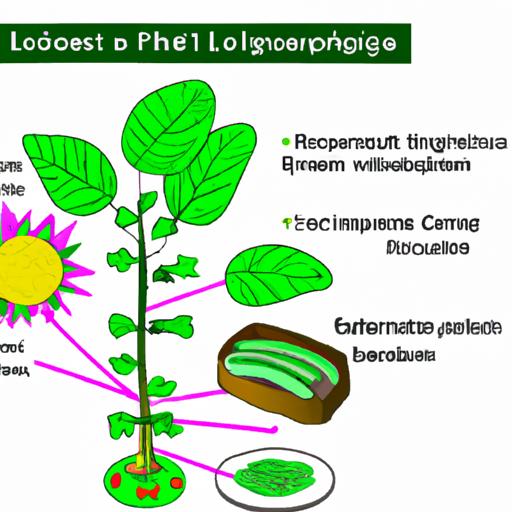Plants, the green wonders of nature, have an undeniable charm that captivates our senses. But have you ever wondered if plants are more than just beautiful adornments in our surroundings? In fact, plants play a crucial role in the ecosystem as producers. In this article, we will delve into the fascinating world of plants and explore their significance as primary producers in the natural world.
A. Definition of Producers in the Ecosystem
To understand the role of plants as producers, let’s first grasp the concept of producers in the ecosystem. Producers, also known as autotrophs, are organisms capable of producing their own food through the process of photosynthesis. They convert sunlight, water, and carbon dioxide into energy-rich carbohydrates, fueling the entire food chain.
B. Explanation of the Importance of Producers
Producers form the foundation of every ecosystem, providing nourishment and energy to all other organisms. Without producers, life as we know it would cease to exist. They are the architects of sustenance, creating a web of life that supports the intricate balance of nature. From microscopic algae in oceans to towering trees in forests, producers are the lifeblood of our planet.
Now that we have a basic understanding of producers in the ecosystem, let’s dive deeper into the world of plants and unravel their remarkable role as primary producers. Stay tuned for the next section, where we will explore the definition and characteristics of plants. Are you ready to embark on this green journey with me? Let’s explore the wonders of plants and their vital contribution as producers in our magnificent ecosystem.
What are Plants? Understanding the Definition and Role of Plants in Ecosystems
A. Definition and Characteristics of Plants
Plants, the silent superheroes of nature, are multicellular organisms belonging to the kingdom Plantae. They exhibit a wide array of shapes, sizes, and forms, ranging from delicate flowers to towering trees. What sets plants apart is their unique ability to produce their own food through photosynthesis, making them autotrophs. With chlorophyll-rich cells, plants harness the power of sunlight to convert carbon dioxide and water into glucose, their primary source of energy.
Plants possess distinct characteristics that allow them to thrive in diverse environments. They have specialized structures such as roots, stems, and leaves that enable them to absorb nutrients from the soil, transport water and minerals, and perform gas exchange. Additionally, plants have the remarkable capacity to reproduce, ensuring the continuity of their species through various mechanisms such as seeds, spores, or vegetative propagation.
B. Role of Plants in Ecosystems
Plants, as primary producers, play an indispensable role in maintaining the delicate balance of ecosystems. They form the foundation of the food chain by converting sunlight into chemical energy through photosynthesis. This energy is stored in the form of complex organic compounds, providing sustenance for herbivores, carnivores, and omnivores.
Moreover, plants contribute to the overall stability of ecosystems by regulating the water cycle. Through transpiration, plants release water vapor into the atmosphere, which eventually leads to the formation of clouds and precipitation. They also act as natural filters, purifying the air we breathe by absorbing pollutants and releasing oxygen as a byproduct of photosynthesis.
In addition to their ecological significance, plants offer numerous benefits to humans. They provide us with food, medicine, timber, and a multitude of resources essential for our survival and well-being. Furthermore, they enhance the aesthetic appeal of our surroundings, creating a serene and harmonious environment that nourishes our souls.
Now that we have a deeper understanding of what plants are and their vital role in ecosystems, let’s delve into the intriguing concept of producers and explore how plants fulfill this crucial role. Stay tuned for the next section, where we will uncover the definition and role of producers in the natural world. Are you ready to continue this botanical adventure with me? Let’s unveil the secrets of producers and their relationship with plants.
Understanding Producers
A. Definition and Role of Producers in Ecosystems
Producers, as we have learned, are the life-givers of the ecosystem. They possess the extraordinary ability to harness the power of sunlight and convert it into organic matter through the process of photosynthesis. By utilizing the energy from the sun, producers create a foundation of sustenance for all other organisms in the ecosystem. They are the ultimate source of nourishment, providing the energy and nutrients that sustain life.
B. Types of Producers in the Natural World
The natural world is abundant with a diverse array of producers, each with its own unique characteristics and contributions. Let’s explore some of the prominent types of producers that exist in our ecosystem:
1. Plants
Plants reign as the most well-known and prevalent type of producer. From the smallest mosses to towering trees, plants dominate terrestrial ecosystems, transforming sunlight into carbohydrates and oxygen through the process of photosynthesis. They provide a haven for countless organisms, serving as habitats, food sources, and crucial contributors to the oxygen cycle.
2. Algae
In aquatic ecosystems, algae take center stage as producers. These simple, photosynthetic organisms can be found in oceans, lakes, and even tiny puddles. Algae play a significant role in water bodies, not only as primary producers but also as oxygenators, purifiers, and vital contributors to the marine food chain.
3. Cyanobacteria
Cyanobacteria, often referred to as blue-green algae, are another group of producers that thrive in diverse environments. They possess the remarkable ability to carry out photosynthesis and are capable of fixing atmospheric nitrogen, enriching the soil and supporting other organisms in the ecosystem.
Understanding the various types of producers in the natural world allows us to appreciate the intricate web of life that exists around us. From the lush forests to the vast oceans, producers are the backbone of every ecosystem, sustaining life and maintaining the delicate balance of nature. As we continue our exploration, let’s turn our attention to plants and explore their remarkable role as primary producers.
Plants as Producers
Plants, with their innate ability to harness the power of sunlight, are the epitome of primary producers in the natural world. Let’s explore the fascinating aspects of plants as primary producers, their extraordinary process of photosynthesis, and the remarkable energy conversion that takes place within them.
A. Explanation of Plants as Primary Producers
Plants, as primary producers, occupy the first trophic level in the food chain. They are responsible for synthesizing organic compounds, such as sugars and carbohydrates, from inorganic substances like carbon dioxide and water. Through this process, plants create the foundation of the food web, serving as a source of energy for various organisms.
B. Process of Photosynthesis in Plants
Photosynthesis, the miraculous phenomenon that occurs within plants, is the key process through which they produce their own food. Within the chloroplasts of plant cells, chlorophyll pigments absorb sunlight, initiating a series of intricate biochemical reactions. Carbon dioxide from the atmosphere combines with water, resulting in the creation of glucose and oxygen.
C. Energy Conversion in Plants
Plants possess a remarkable ability to convert light energy into chemical energy. This energy is stored within the bonds of glucose molecules created during photosynthesis. Some glucose is utilized by plants for growth and metabolic processes, while excess glucose is stored as starch in various plant tissues. This stored energy not only fuels the plant’s own growth but also serves as a vital source of sustenance for other organisms within the ecosystem.
Plants, with their exceptional role as primary producers, play a crucial part in maintaining the delicate balance of our ecosystems. Through their unique ability to convert sunlight into sustenance, they provide nourishment and energy to countless organisms. In the next section, we will delve into the significance of plants as producers, exploring their contribution to oxygen production and their indispensable role in food chains and food webs. Join me as we unravel the captivating world of plants and their invaluable impact on our planet.
Section V: Importance of Plants as Producers
Plants, the unsung heroes of our ecosystem, play a vital role in maintaining the balance of nature. Let’s explore the importance of plants as producers and discover the myriad ways they contribute to our environment and sustenance.
A. Contribution of Plants in Oxygen Production
Have you ever taken a deep breath of fresh air and felt invigorated? You can thank plants for that refreshing experience. Through the process of photosynthesis, plants absorb carbon dioxide and release oxygen, replenishing the air we breathe. In fact, a single mature tree can produce enough oxygen to meet the needs of two to ten people per year! Without plants, our atmosphere would lack the life-sustaining oxygen we depend on.
B. Role of Plants in Food Chains and Food Webs
Imagine a world without food. It’s a bleak and unimaginable scenario. Fortunately, plants as primary producers are the foundation of every food chain and food web. They convert solar energy into organic compounds, providing nourishment for herbivores, which in turn sustain carnivores and other animal species. Plants are the cornerstone of our food systems, supporting both terrestrial and aquatic ecosystems.
C. Environmental Benefits of Plants as Producers
Plants possess remarkable abilities to improve and sustain our environment. Their roots stabilize soil, preventing erosion and landslides. They act as natural filters, purifying water and reducing pollution levels. Additionally, plants absorb harmful greenhouse gases, such as carbon dioxide, mitigating the impact of climate change. Their presence in urban areas also enhances air quality and reduces the heat island effect.
As we unravel the importance of plants as producers, we begin to understand their invaluable contributions to our world. From oxygen production to sustaining food chains, and from environmental benefits to their role in mitigating climate change, plants are true superheroes of the natural world.
Stay tuned for the next section, where we will conclude our exploration of plants as producers and reflect on their significance in our ecosystems. Let’s continue this journey together and celebrate the incredible wonders of plants as the ultimate producers of life.
Conclusion
In conclusion, plants are undeniably the unsung heroes of our ecosystem, serving as vital producers that sustain life on Earth. Through the process of photosynthesis, they convert sunlight, water, and carbon dioxide into energy-rich carbohydrates, providing nourishment for themselves and the entire food chain.
Plants not only produce the oxygen we breathe but also form the foundation of food chains and food webs, providing sustenance for herbivores, carnivores, and omnivores alike. They contribute to the intricate balance of nature, ensuring the survival of countless species and maintaining the health of our planet.
Furthermore, plants offer numerous environmental benefits. They play a crucial role in regulating climate, reducing soil erosion, and improving air quality. Their presence in our surroundings brings beauty and tranquility, soothing our souls and connecting us to the natural world.
Next time you stroll through a lush green meadow or marvel at the majestic trees in a forest, remember that these plants are not just passive bystanders in the backdrop of nature. They are the backbone of our ecosystem, tirelessly working as producers to sustain life and create a harmonious environment for all living beings.
So, the next time you encounter a plant, take a moment to appreciate its remarkable role as a producer. Reflect on the intricate web of life it supports and the profound impact it has on our planet. Let’s cherish and protect these incredible producers, for they are the lifeblood of our existence.




